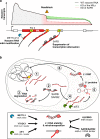Nascent RNA m6A modification at the heart of the gene-retrotransposon conflict
- PMID: 34108664
- PMCID: PMC8324858
- DOI: 10.1038/s41422-021-00518-5
Nascent RNA m6A modification at the heart of the gene-retrotransposon conflict
Conflict of interest statement
G.C. is an unpaid associate editor of the journal
Figures

Comment on
-
The RNA m6A reader YTHDC1 silences retrotransposons and guards ES cell identity.Nature. 2021 Mar;591(7849):322-326. doi: 10.1038/s41586-021-03313-9. Epub 2021 Mar 3. Nature. 2021. PMID: 33658714
References
Publication types
MeSH terms
Substances
Grants and funding
- Idex UCAJEDI, ANR-15-IDEX-01/Agence Nationale de la Recherche (French National Research Agency)
- Labex SIGNALIFE, ANR-11-LABX-0028-01/Agence Nationale de la Recherche (French National Research Agency)
- RetroMet, ANR-16-CE12-0020/Agence Nationale de la Recherche (French National Research Agency)
- ImpacTE, ANR-19-CE12-0032/Agence Nationale de la Recherche (French National Research Agency)
- DEQ20180339170/Fondation pour la Recherche Médicale (Foundation for Medical Research in France)

